History of the Moon Lee Ditch
The Moon Lee Ditch is a historic feature dating prior to 1860 and a primary domestic and
irrigation source for the town of Weaverville. Moon Lee Ditch is a diversion off West Weaver
Creek servicing Weaverville water demands.
West Weaver Creek was an important source of water for mining practices in the Weaverville area
and the Moon Lee Ditch likely originally conveyed water for this purpose. It was later
reconfigured to provide water for domestic and irrigation use for residents on the west side of
Weaverville as the placer mines on the east side of West Weaver Ridge played out. This ditch was
historically known as the Blue Gulch Ditch prior to being referred to as the Moon Lee Ditch and
provided water to the east side of West Weaver Ridge for the Blue Gulch Placer and likely the
McKinzey Placer and Old Andy Placer. According to Donna Kerrigan (former USFS Archaeologist),
this water conveyance system was originally built in the 1850s when it was named Bakers Ditch
(Kerrigan, 1982). Herb Wood’s research states Dick Baker built a ditch in 1862 to supply water
to the Weaverville Townsite (Woods, 1994). The original alignment followed a ditch downhill
(west) from the current alignment, but after 1882 was renamed to Blue Gulch Ditch and realigned
(Woods 1994).
Historically this ditch falls within 3 mining claims. The northern portion of the ditch
(previously known as the Blue Gulch Ditch) traversed through the Senger and Hughes Placer mining
claim, first filed on January 10, 1896 by Jason Singer & Co. In the south, the ditch traversed
through the Manzanita No. 1 Placer and Skib Placer claims. (1936 La Grange Placer Mines
Map).
In 1876 Henry Lorenz filed for the water rights that fed into the “then- unnamed Blue Gulch”
ditch but did not become the owner until 19 May 1889 due to a “series of conveyances between
unnamed mining companies, the Trinity Gold Mining Company, and Henry Lorenz” (Mazzini &
Jensen,1986; p15). At the time Lorenz became the owner of the Blue Gulch Ditch, the ditch took
water below the dam of the Dr. Ware West Weaver Ditch. The water was to be conveyed from the
ditch by a flume to Slaughterhouse Flat and the surplus was to be used for irrigation. In 1917
the ditch and water rights were transferred to the Lorenz Company.
On June 26, 1918 Sam Lee purchased the water rights to two ditches (Sidney Gulch Ditch and
Blue Gulch Ditch) and a 32-acre ranch for $2000 from the Lorenz Company (Deeds 40:352 as cited
in Mazzini & Jensen, 1986). The language in the sale deeded water rights to the Odd Fellows
Cemetery of Weaverville to use the water of either of the ditches for the “purpose of irrigating
the burial plots or lots in said cemetery perpetually hereafter twice a week for a period of two
hours”.
In 1928 the water rights, property, and ditches were transferred to Moon Lee, Sam Lee’s son.
Moon Lee sold the ditch to the California Utilities Corporation in 1968, a company that became
California Pacific Inc. in 1978 (Mazzini & Jensen, 1986: p 15).
In 1975, Will L. Challis (et al.) vs California-Pacific Utilities Co. (et al) resulted in a
Stipulation of settlement of class action in which the water users of the Moon Lee Ditch were to
form a mutual water company (now known as the Moon Lee Ditch Association) and permitted the
users to excess water. In the settlement excess water was defined as all water which
California-Pacific Utilities Co. does not reasonably foresee using in their Weaverville water
system, or which Caliornia-Pacific Utilities Co. does not reasonably believe in its discretion,
should be stored or maintained as a reserve for the Weaverville water system.”
The ditch and water-rights were purchased by the Weaverville Community Services District
(CSD) in 1979. The water right purchased allows the diversion of 3 cubic feet per second
(approximately 1346 gallons per minute).
The ditch was concurred eligible to the National Register of Historic Places (NRHP) on
January 6, 1988 by the California State Historic Preservation Office for its association with
events significant to the broad patterns of our history (California Gold Rush and settlement of
Weaverville) and the association with the lives of persons significant in our past (Moon Lee at
the local level). Moon Lee was a prominent person in the town of Weaverville, serving on the
State Highway Commission and being involved in many civic affairs.
Modern Water Use
In 2022 Weaverville CSD maintains the water rights to the ditch and water moves along the
ditch into an 8in pipeline which carries the water to the Trinco Ln Water Treatment Plant. From
there the water serves the residents on the western side of Weaverville, approximately
everything west of the Courthouse. The excess water is still provided to the Moon Lee Ditch
Association for use in irrigation and water for livestock, however due to wildfire, drought, and
storm damage the ditch line is no longer operational in the USFS and private lands between the
CSD pipeline off the diversion and where the ditch crosses under SR 299. All the excess water is
lost in blow outs along the ditch line.
The Young Family Ranch, Weaverville Cemetery and Moon Lee Ditch Association are working
collaboratively with the CSD to conserve water along the ditch line and reduce the loss of
water. In the future the CSD may transport the allocation of “excess water” through their 8in
pipeline into the Moon Lee Ditch at the Trinco Water Treatment Plant and the Moon Lee Ditch
Association, Young Family Ranch, and Weaverville Cemetery will be able to once again benefit
from the water use and seek to pipe the water to increase the conservation of water.
How may you ask will the water be conserved? By allowing the water to travel through the 8in
pipe water will be saved as every foot of open-unlined ditch losses water due to seepage and
surface water evaporation. Seepage is when water seeps into the soil towards the water table.
The dry months of June, July, August and September are the most critical for water conservation
as these months have the largest loss of water and are most crucial for the fish, frogs and
other species in West Weaver Creek. In 2012-2017 the ditch line lost on average 12.3 million
gallons of water due to seepage and evaporation in these dry water months. This is a loss of
1.16 gallons of water per second during those months, which is equivalent to 0.16 cubic feet per
second. If the water is transported along the 8in pipeline to a smaller distribution pipeline to
the Moon Lee Ditch Association, the Weaverville Cemetery, and the Young Family Ranch we can keep
this water flowing down West Weaver Creek rather than lost along the Moon Lee Ditch.
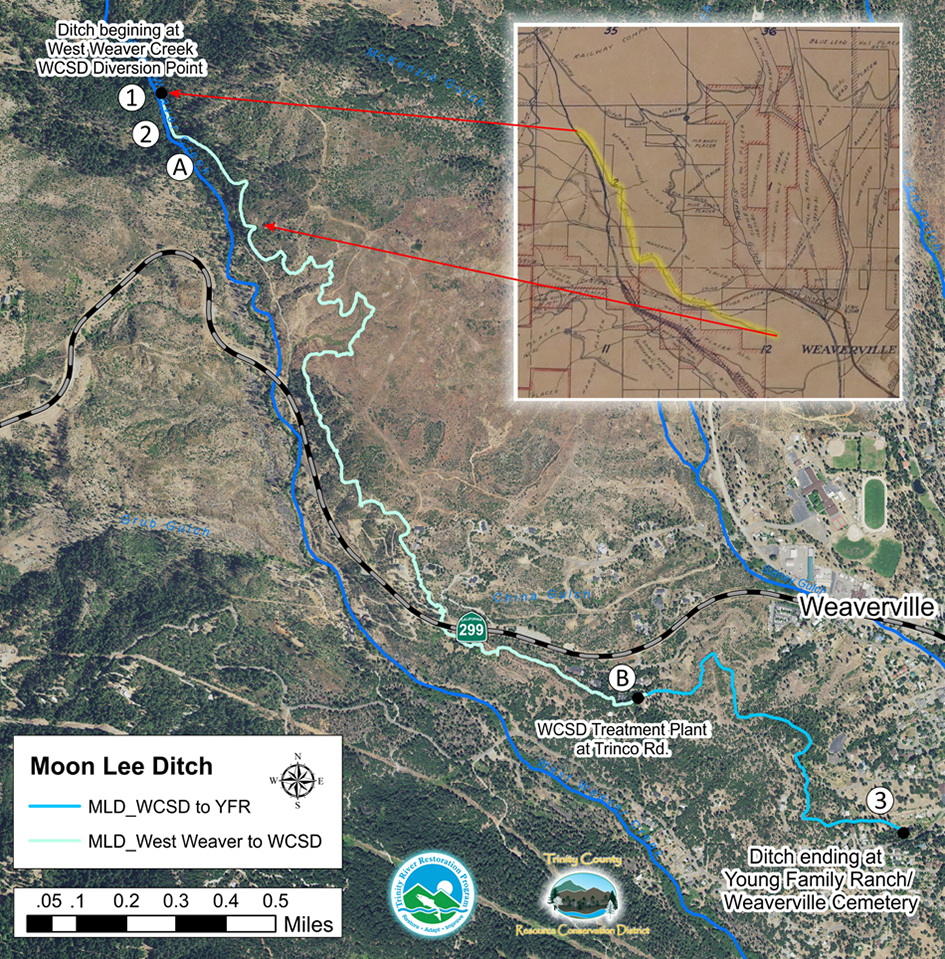
A current map of the Moon Lee Ditch showing the 1936 La Grange Placer Mines Map (inset), highlighted in yellow is the Moon Lee Ditch (formerly Blue Gulch Ditch). Numbered sites are shown below.
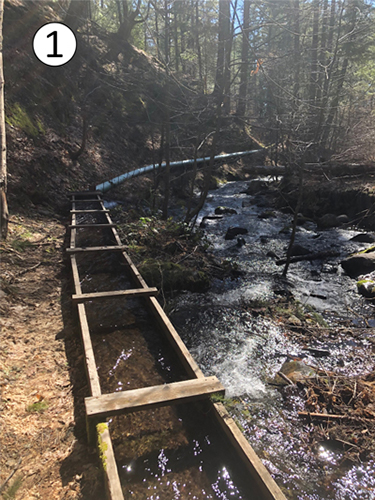
Old mining flume used to convey water for the ditchline.
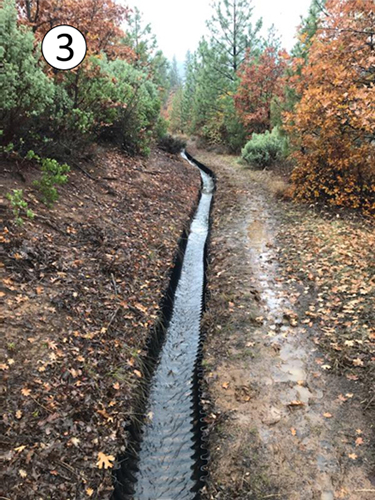
Moon Lee Ditch with water flowing in October of 2021.
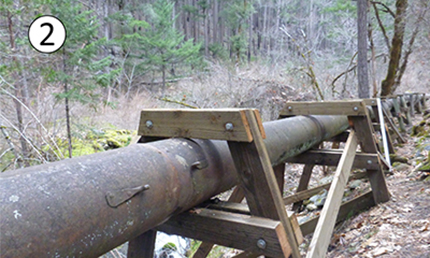
Diversion site of the Moon Lee Ditch on West Weaver.
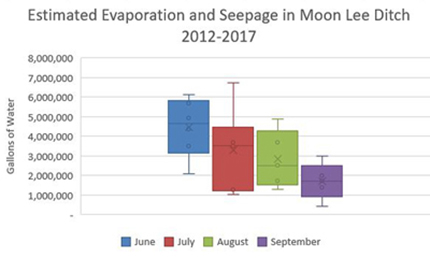
On average 12.3 million gallons of water are lost (A – B on map) due to seepage and evaporation in these dry water months. This is a loss of 1.16 gallons of water per second during those months, which is equivalent to 0.16 cubic feet per second.

